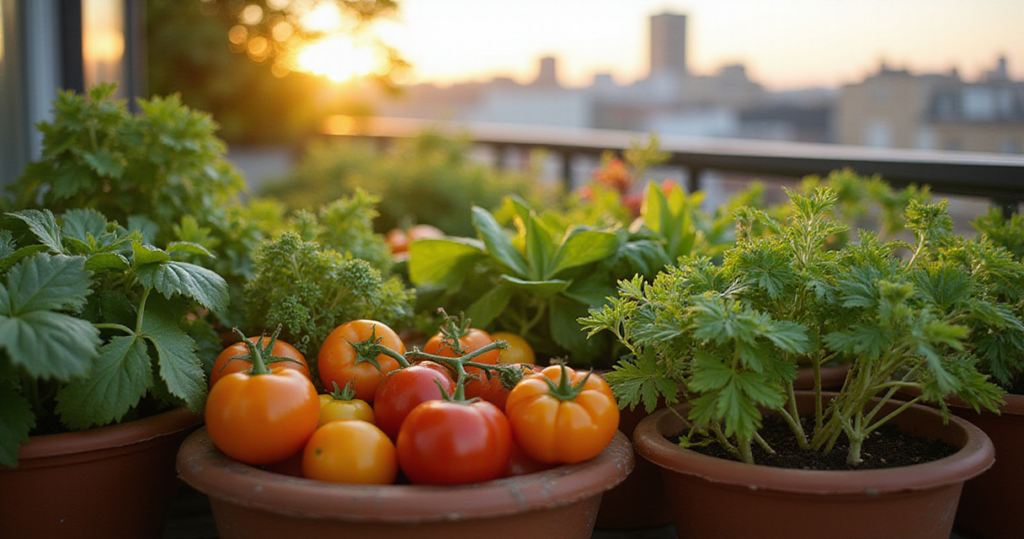As a specialist in universal design, I’ve seen firsthand the power of a space that truly works for everyone. One of the most joyful places to bring this philosophy to life is, surprisingly, in the garden. I remember a client, a retired schoolteacher who used a walker, telling me she thought her gardening days were over. “I can’t get down on my knees anymore, Sam,” she’d said, and the sadness in her voice was palpable. We set her up with a series of containers on her patio, some at bench height, others on casters she could move with a gentle push. The first time I saw her tending her own tomato plants again, sitting comfortably on her walker’s built-in seat, I was reminded of a core truth: good design doesn’t just solve problems; it gives back pieces of our lives we thought were lost.
Container gardening is about so much more than saving space. It’s about bringing the earth up to you. It’s about creating a manageable, accessible patch of nature that can be tended from a chair, a walker, or by a child standing on their tiptoes. It’s the ultimate expression of universal design—an adaptable, beautiful solution that makes the joy of growing your own food possible for anyone, regardless of age, ability, or the size of their backyard. It’s not about limitation; it’s about liberation.
So, let’s dig in. Forget what you think you can’t do. We’re going to walk through how to create a container garden that thrives, one that feeds your body and your spirit. These aren’t just tips; they’re the building blocks for creating your own accessible, productive, and beautiful outdoor space.
1. Choose Compact Varieties Bred for This Very Purpose
The foundation for a great container harvest isn’t in your tools or your soil—it starts at the seed. You wouldn’t try to fit a Great Dane in a studio apartment, and the same logic applies here. Trying to grow a massive, sprawling heirloom tomato in a 10-gallon pot is a recipe for frustration. Instead, you want to look for plants that were born for this life.

When you’re looking at seed packets or plant tags, hunt for keywords like “patio,” “bush,” “dwarf,” or my personal favorite, “determinate.” These are a plant breeder’s signal to you that this variety is designed to be happy in a pot. Determinate tomatoes, for instance, grow to a fixed, manageable size and produce their fruit all at once, rather than vining endlessly. A ‘Bush Blue Lake’ bean gives you a fantastic crop without needing a massive trellis. It’s about working smarter, not harder.
Top choices I recommend to my clients:
- Bush beans: ‘Provider’ or ‘Contender’ are workhorses.
- Determinate tomatoes: ‘Celebrity’ is a classic, but don’t overlook ‘Bush Goliath’.
- Compact peppers: ‘Lunchbox’ snacking peppers are perfect for kids and adults.
- Dwarf eggplants: ‘Fairy Tale’ is as charming as its name and incredibly productive.
- Space-saving cucumbers: Look for ‘Bush Pickle’ or ‘Spacemaster’.
Picking the right plant from the get-go is the kindest thing you can do for your future self. It sets you up for a satisfying win, not a constant battle against a plant that wants more room than you can give.
And once you have the perfect plant, the next logical question is: where is it going to live?
2. Match the Pot to the Plant’s Future
Choosing a container is about more than just aesthetics. The right size pot is the difference between a thriving plant and a stunted, sad one. Frankly, going too small is one of the biggest mistakes I see new container gardeners make. A plant with cramped roots is a stressed plant, and a stressed plant won’t give you much of a harvest.

Think of the pot as the plant’s entire world. Big, hungry vegetables like a tomato or a zucchini need a home that can support them—we’re talking 15 gallons or more. For a pepper or an eggplant, a 5-gallon bucket-sized pot is usually perfect. Leafy greens like lettuce or spinach are much more forgiving and can thrive in just a couple of gallons. For someone using a wheelchair or who prefers to garden while seated, larger, heavier pots offer great stability. They won’t tip if you need to lean on them for support, a small detail that makes a world of difference.
Here’s a quick guide I share with my clients:
- Big Tomatoes (indeterminate): 15-20 gallons. Don’t skimp.
- Peppers & Eggplants: 5-7 gallons.
- Bush Beans & Peas: 2-3 gallons.
- Lettuce & Greens: 1-2 gallons.
- Herbs: 1 gallon is usually plenty.
Choosing the right size feels right, not just for the plant, but for the space. It creates a sense of balance and intention. A tiny plant in a giant pot looks lost, and a huge plant in a tiny pot looks tortured. Get this right, and you’re well on your way.
Now that we have our pot, we have to address the single most important technical detail that can make or break your garden.
3. If It Can’t Drain, It Will Drown
This is non-negotiable. If your pot doesn’t have holes in the bottom, it’s not a planter—it’s a bucket. And plants can’t swim. Waterlogged soil suffocates roots, inviting rot and disease that can wipe out your hard work in a flash. Proper drainage is the life support system for your container garden.

Every single pot must have drainage holes. If you find a beautiful ceramic pot that’s missing them, don’t despair. You can drill your own. Just be sure to use the right kind of bit for the material (a masonry bit for ceramic, for example). And please, let’s bust a myth I hear all the time: putting a layer of gravel or broken pottery in the bottom of your pot does not help drainage. In fact, it does the opposite. It creates a zone of stagnant water—what engineers call a “perched water table”—right where the roots will end up. Just use good soil all the way to the bottom.
To really ensure good flow, I always recommend lifting your pots up slightly. You can use fancy “pot feet,” a couple of bricks, or even leftover pieces of wood. This little bit of airflow underneath prevents the drainage holes from getting plugged and stops water from staining your deck or patio. It’s a simple trick that solves a dozen potential problems.
With drainage sorted, we can finally talk about what goes inside the pot.
4. Don’t Use Dirt from Your Yard. Ever.
You might be tempted to just scoop some soil out of your existing garden bed to fill your pots. Please, resist this urge. Garden soil, when put into a container, becomes heavy, dense, and compacted. It drains poorly, smothers roots, and can be full of weed seeds and soil-borne diseases. It’s just not designed for this environment.

What you need is a high-quality “potting mix.” Notice I said mix, not soil. Most of these are actually soilless. They’re a carefully engineered blend of ingredients designed to provide the perfect balance of moisture retention, drainage, and aeration that roots need to thrive in a container. You’re creating an ideal, fluffy, five-star hotel for your plant’s roots.
When you’re at the store, look for mixes containing:
- Peat moss or coconut coir: These are like sponges; they hold onto moisture.
- Perlite or vermiculite: These little white specks create air pockets for drainage and aeration.
- Composted bark or organic matter: This provides structure and some slow-release nutrients.
Investing in a good potting mix like Pro-Mix or FoxFarm is one of the best investments you can make. It’s the literal foundation of your container garden. Think of it as the difference between building a house on bedrock versus building it on sand.
Now that your plant has a great home, let’s decide where that home is going to sit.
5. Follow the Sun
Most vegetables are sun-worshippers. To produce those delicious tomatoes, peppers, and cucumbers, they need at least 6-8 hours of direct, unfiltered sunlight every day. This is where container gardening offers a huge advantage over in-ground beds: you can move your garden to the sun.

Before you start planting, spend a day playing detective. Watch how the sun moves across your patio, balcony, or yard. Where is the sunniest spot? Is it right by the back door in the morning and on the far corner of the deck in the afternoon? Knowing your space’s “sun map” is crucial. But here’s the best part: you don’t have to get it perfect the first time. I am a huge advocate for putting heavy pots on wheeled plant caddies or dollies. It’s a game-changer, especially for anyone with strength or mobility challenges. It means you can “chase the sun” as the seasons change, or quickly move a heat-sensitive plant into the shade during a brutal heatwave.
This mobility is a core tenet of universal design. It creates a flexible system that adapts to the environment—and to you. For someone who has more energy in the afternoons, you can position the pots where the sun (and you) will be at that time. It’s about designing the task to fit the person, not the other way around.
Sun is the energy source, but plants can’t live on light alone. They need a drink.
6. Become a Watering Whisperer
Plants in containers are entirely at your mercy for water. They can’t send roots deeper into the earth to find moisture. They dry out much faster than plants in the ground, especially on hot, windy days. This means you need a consistent watering strategy.

The best way to know if your plants need water? Ditch the schedule and use your finger. Stick it an inch or two into the soil. If it feels dry, it’s time to water. If it’s damp, you can probably wait. When you do water, do it thoroughly. Pour water on until you see it running freely out of the drainage holes at the bottom. This ensures you’ve soaked the entire root ball and helps flush out any built-up fertilizer salts.
Early morning is the best time to water. It lets the plant “tank up” for the day ahead and allows any water that splashes on the leaves to dry in the sun, which helps prevent fungal diseases. For people who find handling a heavy watering can difficult, a lightweight hose with a gentle spray wand can be a lifesaver. For ultimate ease of use, you can even set up a simple drip irrigation system with a timer. I’ve seen these systems give so much independence back to gardeners who were worried about the physical chore of watering. It’s a perfect example of how adaptive technology can support a passion.
Of course, with all that water flushing through the pot, it’s taking something with it.
7. Plan Regular Meals for Your Plants
All that thorough watering that’s so good for the roots? It also flushes nutrients right out of the pot. Think of it like a constantly leaky cup. To keep your plants growing strong and producing fruit, you need to replenish those nutrients regularly.

This is where a consistent feeding schedule comes in. During the main growing season, I typically recommend feeding my clients’ container gardens every 1-2 weeks with a balanced liquid fertilizer, usually diluted to half-strength. When you see flowers start to form and fruit begin to set, that’s the plant’s way of saying, “I’m working really hard now, I need more food!” You can increase feeding during this period.
I’m a big fan of organic options like fish emulsion or liquid kelp. They smell a bit… earthy… for a few hours, but they are fantastic for building healthy soil life in the pot. Pay attention to your plants. They’ll tell you what they need. Yellowing leaves often signal a need for nitrogen. Don’t overdo it, though. Too much fertilizer can give you a huge, beautiful green plant with no fruit, which is a bit of a letdown.
Your well-fed plants will start growing enthusiastically, which leads us to the next challenge: keeping them upright.
8. Provide Support Before They Ask for It
Many vegetable plants, especially vining ones like tomatoes and cucumbers, will collapse into a tangled mess without something to climb on. Even bushier plants like peppers and eggplants can get so heavy with fruit that their branches will snap. The solution is simple: give them some support.

The crucial part here is timing. Install your supports—be it a tomato cage, a stake, or a small trellis—when you first plant the seedling. Trust me on this. Trying to wrestle a cage around a two-foot-tall tomato plant without breaking branches is a frustrating exercise that often ends in tears. Doing it early allows the plant to grow up into its support naturally. It’s a “do it once, do it right” approach that saves you a major headache later.
What kind of support you need depends on the plant:
- Big Vining Tomatoes: They will laugh at flimsy, cone-shaped cages. You need a heavy-duty cage or a tall, sturdy staking system.
- Bush Tomatoes: A standard cage or a single stake works well.
- Cucumbers & Pole Beans: A trellis they can climb is ideal.
- Peppers & Eggplants: A single stake next to the main stem is often all they need.
Proper support isn’t just about preventing breakage. It lifts the foliage and fruit off the soil, which dramatically improves air circulation and reduces the risk of disease. It also makes harvesting so much easier, which is, after all, the entire point.
Now that the plant is supported structurally, let’s talk about how to shape its growth.
9. Pruning is a Conversation with Your Plant
Pruning can feel intimidating, like you might hurt the plant. But it’s better to think of it as a way to help the plant focus its energy. In the tight quarters of a container, strategic pruning helps create a healthier, more productive, and more manageable plant.

For tomatoes, the classic target for pruning is the “suckers”—those little shoots that pop up in the V-shape between the main stem and a branch. If you let them go, they’ll turn into whole new main stems, creating a dense, tangled jungle that’s hard to manage and prone to disease. Pinching them off when they’re small redirects all that energy into making bigger, better tomatoes on the main stems. For herbs like basil, pinching off the top set of leaves encourages the plant to grow bushier and fuller, and it stops it from flowering too early (which can make the leaves bitter).
Always use clean, sharp pruners or scissors. A clean cut heals faster and is less likely to introduce disease. I’ve seen people avoid pruning altogether out of fear, only to end up with a huge, unwieldy plant that produces very little. And on the flip side, I’ve seen others get a little too enthusiastic and remove too much foliage at once, which can shock the plant. It’s a balance. Just start small. A little bit of pruning goes a long way.
While you’re in there, up close and personal with your plants, you should be looking for uninvited guests.
10. Be a Good Detective for Pests & Diseases
Container gardens are a small, concentrated ecosystem, which means a small pest or disease problem can become a big one fast. The key is early detection. Make a habit of really looking at your plants every day or two. It doesn’t have to be a long inspection, just a quick check-in while you’re watering.

Turn over a few leaves. Are there tiny whiteflies? A sticky residue (that’s called honeydew, and it’s a sign of aphids)? Fine, silky webs on the underside of leaves? Those are spider mites. Holes chewed in the leaves could be caterpillars. A white, powdery coating on squash leaves is the classic sign of powdery mildew.
When you find something, act fast. Often, you can solve the problem without resorting to harsh chemicals. A strong blast of water from the hose can dislodge aphids and spider mites. Insecticidal soap, which you can buy or make yourself, is a great organic control for many soft-bodied pests. And one of the simplest and most effective things you can do is to improve air circulation—which brings us right back to good support and pruning. Seeing a problem early means you can often solve it with a small, gentle intervention.
One of the easiest ways to improve conditions for all your plants is simple movement.
11. Give Your Plants a Turn
Have you ever noticed how houseplants on a windowsill tend to lean dramatically toward the light? Your outdoor plants do the same thing. This can lead to lopsided growth, with one side of the plant lush and green and the other side sparse and shaded. For fruiting vegetables, this can mean that one side ripens beautifully while the other stays green.

The fix is incredibly simple: give your pots a little turn every few days. A quarter-turn is all it takes to ensure that every part of the plant gets its share of sunlight. I often tell my clients to put a small, discreet mark on one side of the pot so they can keep track of where they are in the rotation.
This is another area where those wheeled caddies are worth their weight in gold, especially for large, heavy pots. What would be a difficult chore becomes an easy, two-second task. It’s a small act of attention that promotes stronger, more even growth and a better, more uniform harvest.
Now, let’s think beyond the horizontal and look up.
12. Grow Up! Maximizing Vertical Space
For anyone with a small patio or balcony, thinking vertically is the secret to a surprisingly large harvest. Going up dramatically increases your growing area without taking up another square inch of floor space. It’s also a fantastic strategy for accessibility, as it brings the garden up to a comfortable working height.

Vining plants like cucumbers, pole beans, and some types of squash are natural climbers. Give them a trellis or some netting to cling to, and they will happily grow upwards. Hanging baskets are perfect for trailing plants—imagine a cascade of ‘Tumbling Tom’ cherry tomatoes or a mix of strawberries and herbs. Tiered or “stadium-style” plant stands let you create a wall of green, ensuring every pot gets good light.
My personal favorite for universal design is wall-mounted planters or vertical garden systems. You can install these at the perfect height for someone gardening from a seated position, eliminating bending and reaching entirely. It transforms a blank wall into a living, productive, and beautiful feature. This isn’t just gardening; it’s landscape design on an intimate, accessible scale.
Thinking vertically is a great space-saving trick, but so is thinking about time.
13. Stagger Your Harvest with Succession Planting
One of the “problems” with a successful garden is that you can suddenly find yourself with four pounds of lettuce that all needs to be eaten right now. Succession planting is the clever solution to this boom-and-bust cycle. It’s the simple act of staggering your plantings to ensure a steady, continuous harvest over a long period.

This works best with fast-growing crops. Instead of planting all your radish seeds at once, plant a small row today, another small row in two weeks, and another two weeks after that. Do the same with bush beans, lettuce, spinach, and cilantro. As one batch is finishing up, the next one is just starting to mature. You’ll never be overwhelmed, and you’ll never be without.
To make this work, it helps to start seeds in small trays so you have a new round of “babies” ready to go into a container as soon as you harvest the previous crop. It takes a little bit of planning—and keeping a simple garden journal really helps—but it turns your small container garden into a hyper-productive, season-long resource.
Part of that planning involves thinking about the toughest part of the season.
14. Pick Plants That Can Take the Heat
Summer heat can be brutal on container plants. The soil in a pot heats up much faster and more intensely than the ground does, which can stress roots and cause plants to wilt and stop producing. Especially if you live in a hot climate, choosing heat-tolerant varieties is a must.

Breeders have developed some incredible varieties that don’t just survive the heat, they thrive in it. Look for tomatoes like ‘Phoenix’ or ‘Heatmaster’. There are even lettuce varieties like ‘Jericho’ that resist “bolting” (going to seed and turning bitter) when temperatures soar. Many of the plants we associate with summer, like most peppers and eggplants, are naturally well-suited to heat.
You can also help your plants cope. Light-colored pots will reflect sunlight and keep roots cooler than dark pots will. A 2-inch layer of mulch on top of the soil—like straw or shredded leaves—acts like insulation, helping to moderate soil temperature and retain moisture. On the most extreme days, a bit of afternoon shade from a patio umbrella or a piece of lightweight shade cloth can make all the difference.
Keeping roots cool is a water-saving strategy, but there are others.
15. Garden Smarter, Not Thirstier
Water conservation is just good practice, but it’s especially smart in container gardening where plants rely so heavily on you. There are several easy ways to be more water-wise without sacrificing your plants’ health.

We already mentioned mulch, and it’s so important I’ll say it again. A layer of organic mulch (straw, shredded bark, compost) is the single best thing you can do to reduce evaporation from the soil surface. Another great option is to invest in self-watering containers. These have a built-in reservoir at the bottom that wicks water up to the roots as needed. They can be a total game-changer for people who travel or who find daily watering to be a challenge. I’ve seen them extend the time between waterings from one day to five, or even more.
Finally, a simple tip: group your pots. Put all the thirsty plants like tomatoes and cucumbers together, and keep the more drought-tolerant herbs like rosemary and thyme in a separate area. This lets you water more efficiently, giving each plant what it needs without wasting a drop.
Smart watering leads naturally to smart planning for the whole year.
16. Plan for the Changing of the Seasons
A truly great container garden doesn’t just exist in July. With a bit of forethought, you can get productive harvests in spring, summer, and fall, and even prepare for winter. The key is to think of your garden in seasons and to plan your transitions.

Start with your local frost dates. This will tell you when it’s safe to put out warm-season plants like tomatoes and peppers, and when you should be planting cool-season crops like peas, lettuce, and kale for a spring or fall harvest. Your containers give you a huge advantage here. You can start cool-season crops in late summer in a shadier spot and then move them into the full sun as the weather cools.
And because your garden is mobile, you can cheat the seasons. Have some frost blankets or even just an old bedsheet ready for those unexpectedly cold spring or fall nights. A simple cover can protect your plants and give you several extra weeks of growing time. Planning for these transitions means you’re not just reacting to the weather; you’re working with it.
When you manage your garden so well, you’ll be rewarded with produce, and you need to know when it’s ready.
17. Know When to Pick
Harvesting at just the right moment is how you capture the peak flavor and nutrition of everything you grow. It’s an art that you’ll learn through observation, and it’s one of the most satisfying parts of gardening. Plus, for many plants, regular harvesting is a signal to produce more.

Leafy greens are best picked in the cool of the morning when their leaves are full of water and perfectly crisp. Tomatoes and peppers should have their full, deep color and should feel firm but give just slightly when you press gently. Herbs have the most intense flavor and essential oils right before they start to flower. With zucchini and cucumbers, it’s better to pick them when they’re a bit smaller and more tender. A giant zucchini might look impressive, but the flavor and texture are much better on a younger one.
Always use a sharp, clean pair of scissors or pruners. This makes for a clean cut that won’t damage the rest of the plant. A gentle hand prevents bruising. The feeling of stepping out your door to snip the exact herbs you need for dinner is a simple, profound pleasure.
And that pleasure doesn’t have to end when the first frost looms.
18. Extend the Season, Extend the Joy
The mobility of containers is your secret weapon for stretching the growing season. That pepper plant that’s still covered in fruit when a frost is forecast? You don’t have to sacrifice it. You can just move it into a protected garage, a sunroom, or even indoors for a few nights.

With a little planning, you can significantly extend your harvest. A simple, inexpensive cold frame or a mini greenhouse can protect cool-season crops like kale and spinach well into the winter in many climates. In fact, the flavor of some of these crops, like kale and Brussels sprouts, actually improves after a light frost. I’ve had clients who successfully overwintered pepper plants indoors near a sunny window, getting a second year of production from the same plant.
This ability to adapt and protect your plants is liberating. It moves you from being a passive recipient of the weather to an active manager of your garden’s microclimate. It’s about anticipating change and having a plan, which is a core idea in future-proofing a home and a lifestyle.
This long-term view applies to your soil, too.
19. Keep Your Soil Alive and Well
After a long season of growing and feeding a hungry vegetable plant, the soil in your container is going to be tired and depleted. Because it’s a closed system, you can’t rely on earthworms and natural processes to rejuvenate it. You have to take an active role in maintaining its health.

At the end of a season, I advise my clients to either replace the potting mix or to amend it heavily. This means mixing in a generous amount of fresh compost. This replenishes the organic matter and nutrients that were used up. For heavy feeders like tomatoes, it’s best to start with fresh potting mix each year.
It’s also a good idea to practice crop rotation, even in pots. Try not to plant the same type of vegetable (or one from the same family) in the same pot year after year. For example, tomatoes, peppers, and eggplants are all in the nightshade family and are susceptible to similar diseases. Rotating them to different pots with fresh soil helps break that disease cycle. Maintaining your soil is how you ensure your garden is sustainable and productive for years to come.
An even more proactive way to deal with disease is to choose plants that fight their own battles.
20. Choose Varieties with Built-In Resilience
One of the most powerful and low-effort ways to ensure a healthy garden is to select varieties that are naturally resistant to common diseases. Plant breeders have done amazing work developing cultivars that can shrug off diseases that would devastate older, more susceptible types. This is a huge benefit in a container garden where diseases can spread quickly.

When you’re looking at a plant tag or seed packet, especially for tomatoes, you’ll often see a string of letters after the name, like ‘Celebrity VFNTA’. Those aren’t a typo. They’re a code for its resistances: V for Verticillium wilt, F for Fusarium wilt, N for Nematodes, and so on. Choosing a variety with a good resistance package is like giving your plant a series of vaccinations.
Does it mean the plant is invincible? No. But it does mean it has a much better chance of staying healthy and productive, even if disease pathogens are present in your area. It reduces your stress and minimizes the need for sprays or other interventions. It’s just another way of setting yourself up for success from the very beginning.
Instead of fighting the bad guys, you can also invite in some good guys.
21. Create a Welcome Mat for Helpful Bugs
Not every insect in your garden is an enemy. In fact, many are powerful allies. Beneficial insects like ladybugs, lacewings, and tiny parasitic wasps are voracious predators of pests like aphids. Pollinators, of course, are essential for any fruiting crop. By planting a few specific things, you can roll out the welcome mat for this free, natural pest control service.

The trick is to plant flowers that these helpers love. Herbs like dill, cilantro, and parsley, if you let a few of them go to flower, are fantastic attractants. Simple, sweet-smelling flowers like sweet alyssum or calendula provide nectar and pollen that beneficials need to survive. I love interplanting these among my vegetable containers. It doesn’t take up much space, adds a splash of color, and creates a small, balanced ecosystem.
By creating this habitat, you’re building a more resilient garden that can better manage pest outbreaks on its own. You’re supporting local biodiversity and reducing, or even eliminating, the need for any kind of pesticide. It’s a beautiful, living system that works in harmony.
And to remember what works year after year, there’s one final, crucial step.
22. Become the Historian of Your Garden
This might sound like homework, but trust me, keeping a simple garden journal is the most valuable tool you can have. Your memory is not as good as you think it is. After a few seasons, you won’t remember which tomato variety did so well, or exactly when you started seeing spider mites, or which pepper plant hated that hot corner of the patio.

Your records don’t have to be elaborate. A simple notebook will do. Jot down what you planted and when. Note which container size you used. Make a note of when you harvested, and how it tasted. Did a particular variety struggle? Why do you think that was? Taking a few photos with your phone can also be incredibly helpful.
This record-keeping turns every season into a learning experience. You’ll start to see patterns. You’ll be able to look back and say, “Ah, the ‘Patio Princess’ tomato was way more productive than the ‘Bush Goliath’ in my conditions.” It transforms you from a novice just trying things into an expert on your own specific garden. This accumulated knowledge is the true secret to long-term success.
It’s Your Garden, on Your Terms
Ultimately, container gardening is a beautiful expression of empowerment. It puts you in control. It allows you to create a garden that fits your space, your body, your abilities, and your life. Whether you are navigating a mobility challenge, living in a multigenerational household where everyone wants to participate, or simply want to have more control over the food you eat, containers provide the ultimate flexible solution.
Don’t feel like you have to do all 22 of these things perfectly on day one. Start with the basics: a good pot with good drainage, the best potting mix you can afford, and a plant bred for success. Get the watering down. The rest will follow.
As I’ve seen time and time again, creating a space that adapts to you—a space built on the principles of universal design—is what turns a house into a home and a patio into a sanctuary. Your container garden will become a source of nourishment, pride, and simple, daily joy. Now go get your hands dirty.






